Name Willie Sutton Number 11 | Caught February 1952 Added March 20, 1950 | |
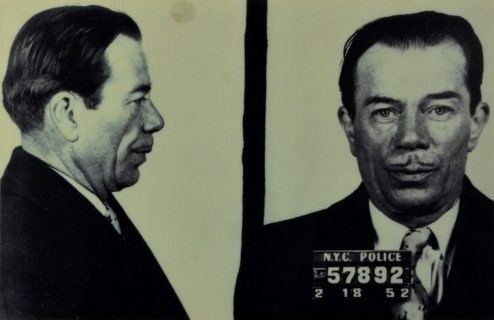 | ||
Full Name William Francis Sutton, Jr. Born June 30, 1901Brooklyn, New York ( 1901-06-30 ) Died November 2, 1980, Spring Hill, Florida, United States Similar J R Moehringer, Arnold Schuster, Frederick J Tenuto | ||
William Francis "Willie" Sutton, Jr. (June 30, 1901 – November 2, 1980) was an American bank robber. During his forty-year robber career he stole an estimated $2 million, and he eventually spent more than half of his adult life in prison and escaped three times. For his talent at executing robberies in disguises, he gained two nicknames, "Willie the Actor" and "Slick Willie". Sutton is also known as the namesake of Sutton's law, although he denied originating it.
Contents
- Interview rich gold in the footsteps of willie sutton
- Willie Sutton The Gentleman Bank Robber I Rob Banks Because Thats Where the Money Is
- Early life
- Career in crime
- Personal life and death
- Suttons law
- References
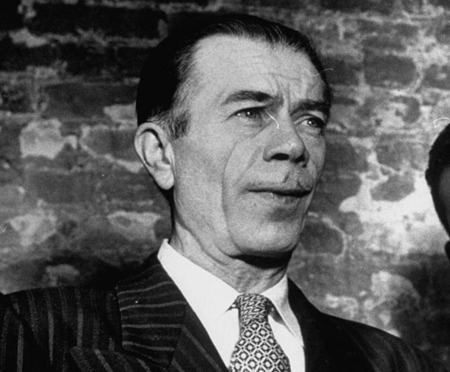
Interview rich gold in the footsteps of willie sutton
Willie Sutton: The Gentleman Bank Robber - " I Rob Banks Because That's Where the Money Is"
Early life
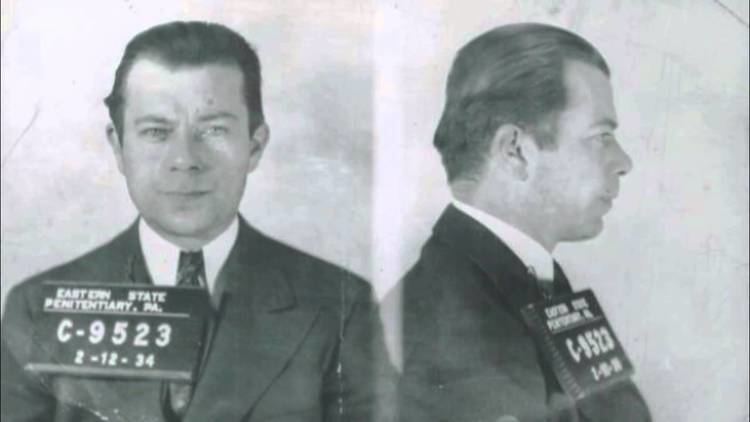
Sutton was born into an Irish-American family on June 30, 1901. The family lived on the corner of Gold and Nassau Streets in the neighborhood of Irishtown, Brooklyn, now called Vinegar Hill. According to his biography, "Where the Money Was", at the age of three the family moved to High Street. His father, William Sutton Sr., was a blacksmith. His mother was Mary Ellen Bowles and, according to the biography, born in Ireland; however, according to the 1910 U.S. Census, she was born in Maryland and her parents were born in Ireland. By 1910, she had given birth to five children, of which three were still alive. According to the 1910 Census, his maternal grandfather, James Bowles, and his two maternal uncles were also living with the family. Sutton was the fourth of five children, and did not go beyond the 8th grade of school.
Career in crime
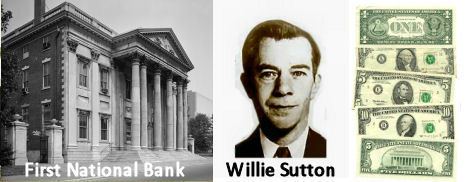
He turned to crime at an early age, though throughout his professional criminal career, he did not kill anyone. Described by Mafioso Donald Frankos as "a little bright-eyed guy, just 5'7" and always talking, chain-smoking ... cigarettes with Bull Durham tobacco." Frankos stated also that Sutton "dispensed mounds of legal advice" to any convict willing to listen. Inmates considered Sutton a "wise old head" in the prison population. When incarcerated at "The Tombs" (Manhattan House of Detention) he did not have to worry about assault because Mafia friends looked after him. In conversation with Donald Frankos he would sadly reminisce about the violent and turbulent days in the 1920s and 1930s while he was most active in robbing banks and would always tell fellow convicts that in his opinion, during the days of Al Capone and Charles Luciano, better known as Lucky Luciano, the criminal underworld was the bloodiest. Gangsters from the time period, and many incarcerated organized crime mafia family leaders and made Mafiosi, loved having Sutton around for companionship. He was always a gentleman, witty and non-violent. Frankos declared that Sutton made legendary bank thieves Jesse James and John Dillinger look like amateurs.
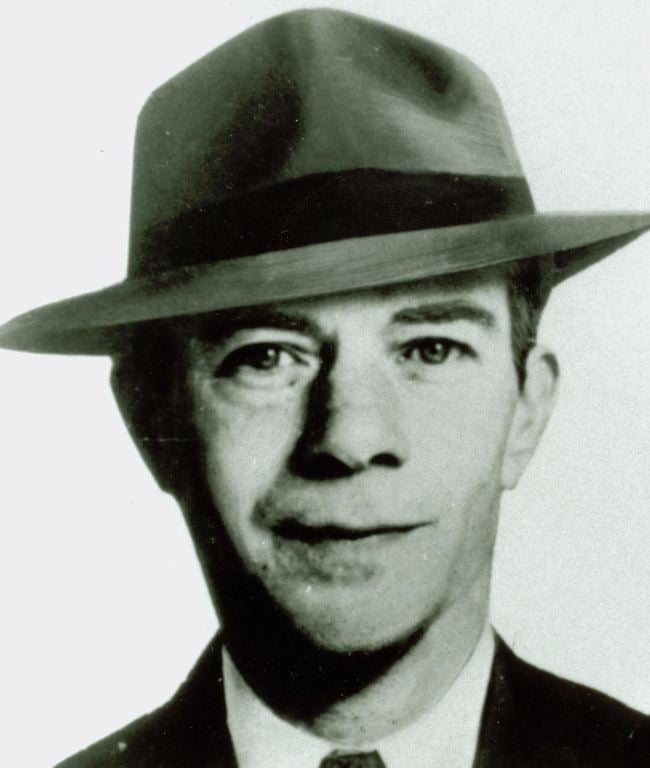
Sutton was an accomplished bank robber. He usually carried a pistol or a Thompson submachine gun. "You can't rob a bank on charm and personality," he once observed. In an interview in the Reader's Digest published shortly before his death, Sutton was asked if the guns that he used in robberies were loaded. He responded that he never carried a loaded gun because somebody might get hurt. He stole from the rich and kept it, though public opinion later turned him into a perverse type of Robin Hood figure. He allegedly never robbed a bank when a woman screamed or a baby cried.
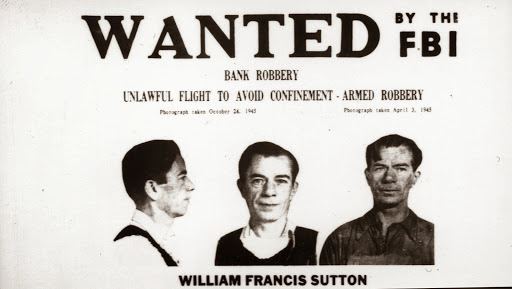
Sutton was captured and recommitted in June 1931, charged with assault and robbery. He did not complete his 30-year sentence, escaping on December 11, 1932, using a smuggled gun and holding a prison guard hostage. With the guard as leverage, Sutton acquired a 45-ft (13.5 meter) ladder to scale the 30-ft (9 meter) wall of the prison grounds.
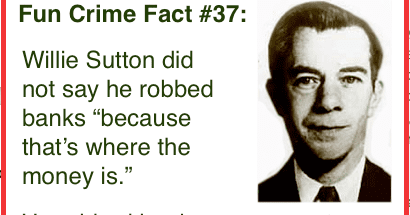
On February 15, 1933, Sutton attempted to rob the Corn Exchange Bank and Trust Company in Philadelphia, Pennsylvania. He came in disguised as a postman, but an alert passerby foiled the crime. Sutton escaped. On January 15, 1934, he and two companions broke into the same bank through a skylight.
The FBI record observes:
Sutton also conducted a Broadway jewelry store robbery in broad daylight, impersonating a postal telegraph messenger. Sutton's other disguises included a police officer, messenger and maintenance man. He usually arrived at banks or stores shortly before they opened for business.
Sutton was apprehended on February 5, 1934, and was sentenced to serve 25 to 50 years in the Eastern State Penitentiary in Philadelphia, Pennsylvania, for the machine gun robbery of the Corn Exchange Bank. On April 3, 1945, Sutton was one of 12 convicts who escaped the institution through a tunnel. Sutton was recaptured the same day by Philadelphia police officer Mark Kehoe.
Sentenced to life imprisonment as a fourth time offender, Sutton was transferred to the Philadelphia County Prison, Holmesburg section of Philadelphia, Pennsylvania. On February 10, 1947, Sutton and other prisoners dressed up as prison guards. The men carried two ladders across the prison yard to the wall after dark. When the prison's searchlights hit him, Sutton yelled, "It's okay!" No one stopped him.
On March 20, 1950, Sutton was the eleventh listed on the FBI's brand new FBI Ten Most Wanted Fugitives, created only a week earlier, on March 14.
In February 1952, Sutton was captured by police after having been recognized on a subway and followed by Arnold Schuster, a 24-year-old Brooklyn clothing salesman and amateur detective. Schuster later appeared on television and described how he had assisted in Sutton's apprehension. Albert Anastasia, Mafia boss of the Gambino crime family, took a dislike to Schuster because he was a "squealer". According to Mafia turncoat and government informant, Joe Valachi, Anastasia ordered the murder of Schuster, who was then shot dead outside his home on March 9, 1952.
Judge Peter T. Farrell presided over a 1952 trial in which Sutton was convicted of the 1950 robbery of $63,942 (equal to $636,501 today) from a branch of the Manufacturers Trust Company in Sunnyside, Queens. He received a sentence of 30 to 120 years in Attica State Prison.
In December 1969, in response to a motion by Sutton's attorneys, Farrell ruled that Sutton's good behavior in prison and his deteriorating health due to emphysema justified commutation of his sentence to time served. At the hearing Sutton responded, "Thank you, your Honor. God bless you," and wept as he was led out of the court building. In 1970, a separate 30-years-to-life sentence handed down in Brooklyn in 1952 was also commuted on similar grounds, and he was released on parole.
After his release Sutton delivered lectures on prison reform and consulted with banks on theft deterrent techniques. He made a television commercial for New Britain Bank and Trust Company in Connecticut for their credit card with picture ID on it. His lines were, "They call it the 'face card.' Now when I say I'm Willie Sutton, people believe me."
Personal life and death
Sutton married Louise Leudemann in 1929. She divorced him while he was in jail. Their daughter Jeanie was born the following year. His second wife was Olga Kowalska, whom he married in 1933. His longest period of (legal) employment lasted for 18 months.
A series of decisions by the United States Supreme Court in the 1960s led to his release on Christmas Eve, 1969, from Attica State Prison. He was in ill health at the time, suffering from emphysema and in need of an operation on the arteries of his legs.
Sutton died in 1980 at the age of 79; before this he had spent his last years with his sister in Spring Hill, Florida. He frequented the Spring Hill Restaurant where he kept to himself. After Sutton's death, his family arranged a quiet burial in Brooklyn in the family plot.
Sutton's law
In a famous apocryphal story, Sutton was asked by reporter Mitch Ohnstad why he robbed banks. According to Ohnstad, he replied, "Because that's where the money is." The quote evolved into Sutton's law, which is often invoked to medical students as a metaphor for focusing a workup on the most likely diagnosis, rather than wasting time and money investigating every conceivable possibility.
In his autobiography, Sutton denied originating the pithy rejoinder:
The irony of using a bank robber's maxim as an instrument for teaching medicine is compounded, I will now confess, by the fact that I never said it. The credit belongs to some enterprising reporter who apparently felt a need to fill out his copy. I can't even remember where I first read it. It just seemed to appear one day, and then it was everywhere.
If anybody had asked me, I'd have probably said it. That's what almost anybody would say ... it couldn't be more obvious.
Or could it?
Why did I rob banks? Because I enjoyed it. I loved it. I was more alive when I was inside a bank, robbing it, than at any other time in my life. I enjoyed everything about it so much that one or two weeks later I'd be out looking for the next job. But to me the money was the chips, that's all.
The Redlands Daily Facts published the earliest documented example of Sutton's law on March 15, 1952 in Redlands, California.
A corollary, the "Willie Sutton rule," used in management accounting, stipulates that activity-based costing (in which activities are prioritized by necessity, and budgeted accordingly) should be applied where the highest costs occur, because that is where the biggest savings can be found.
